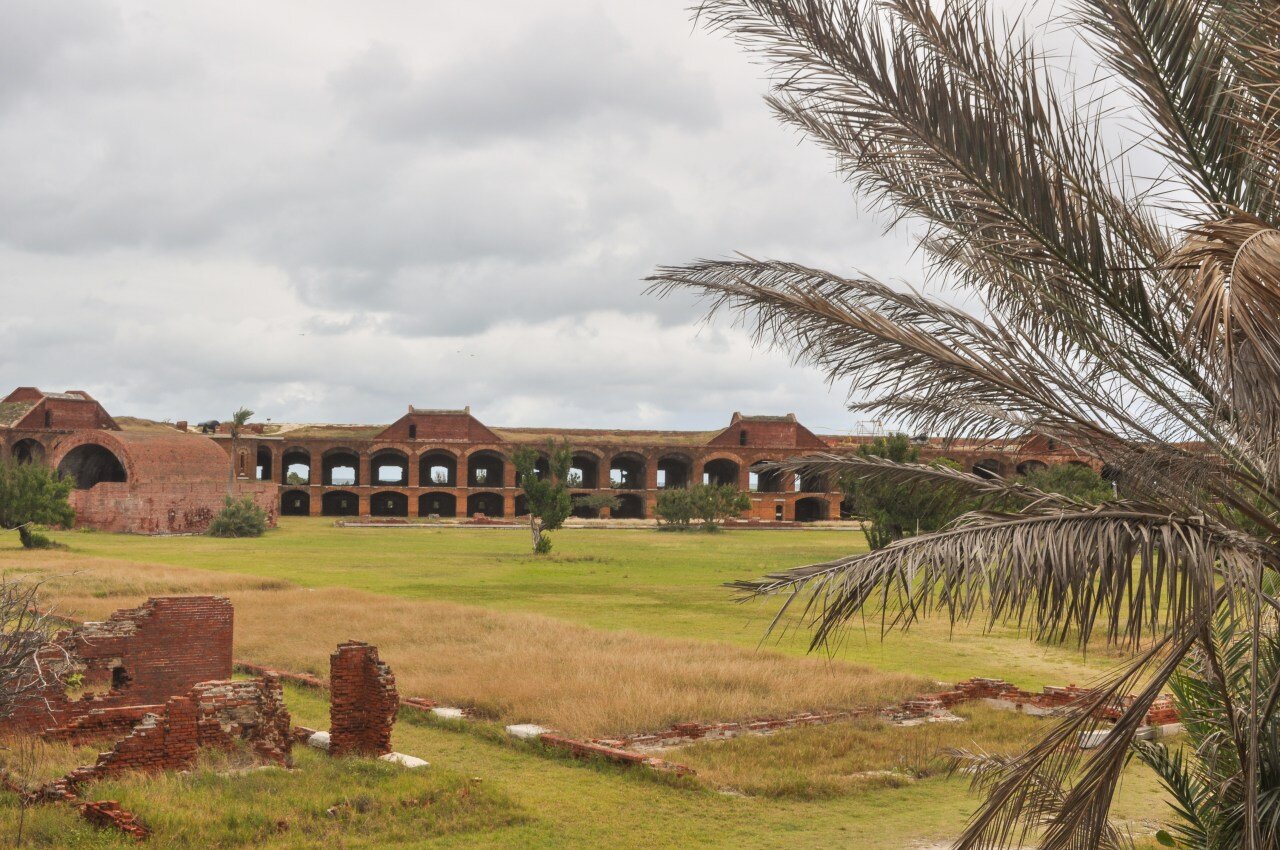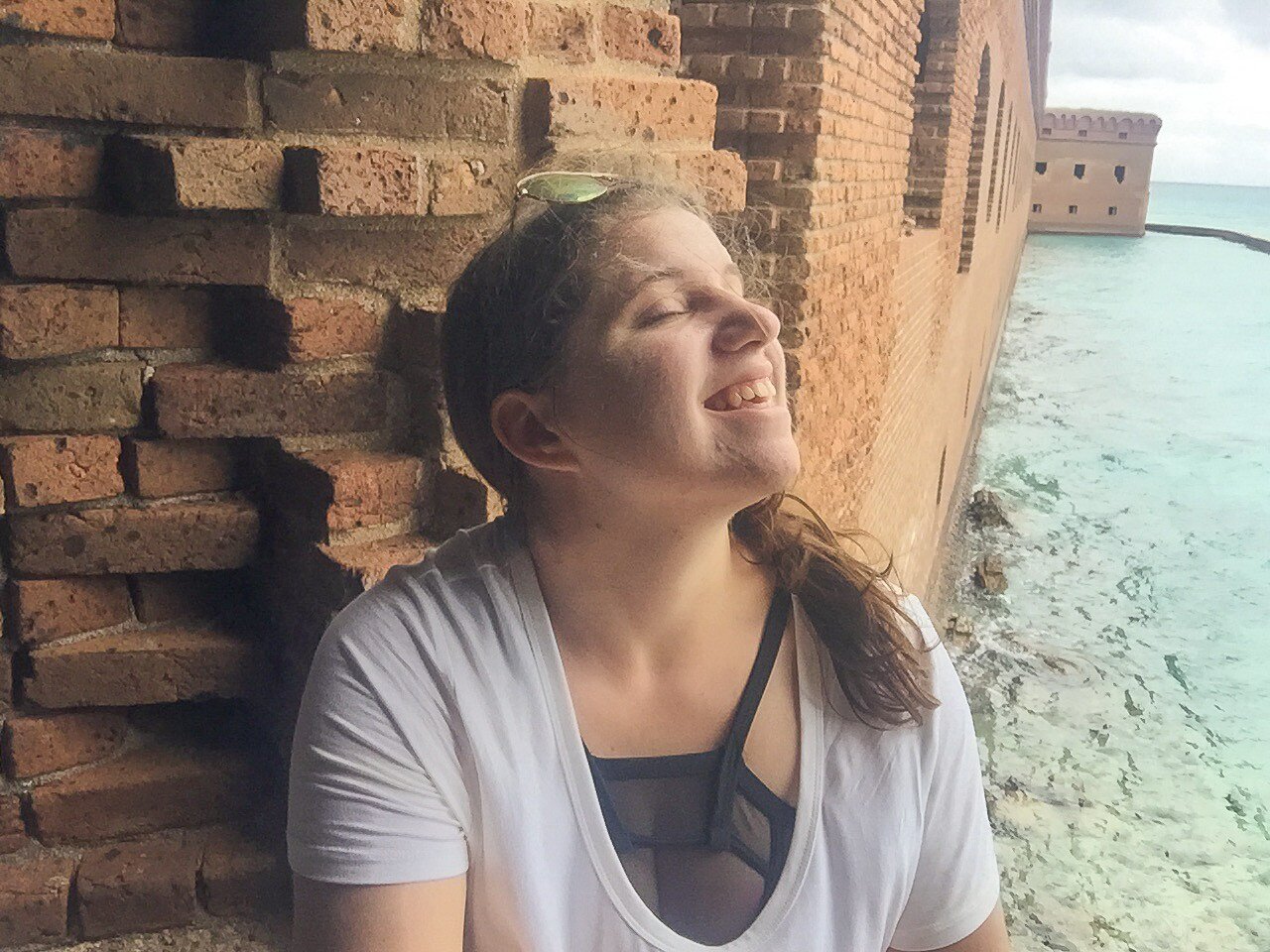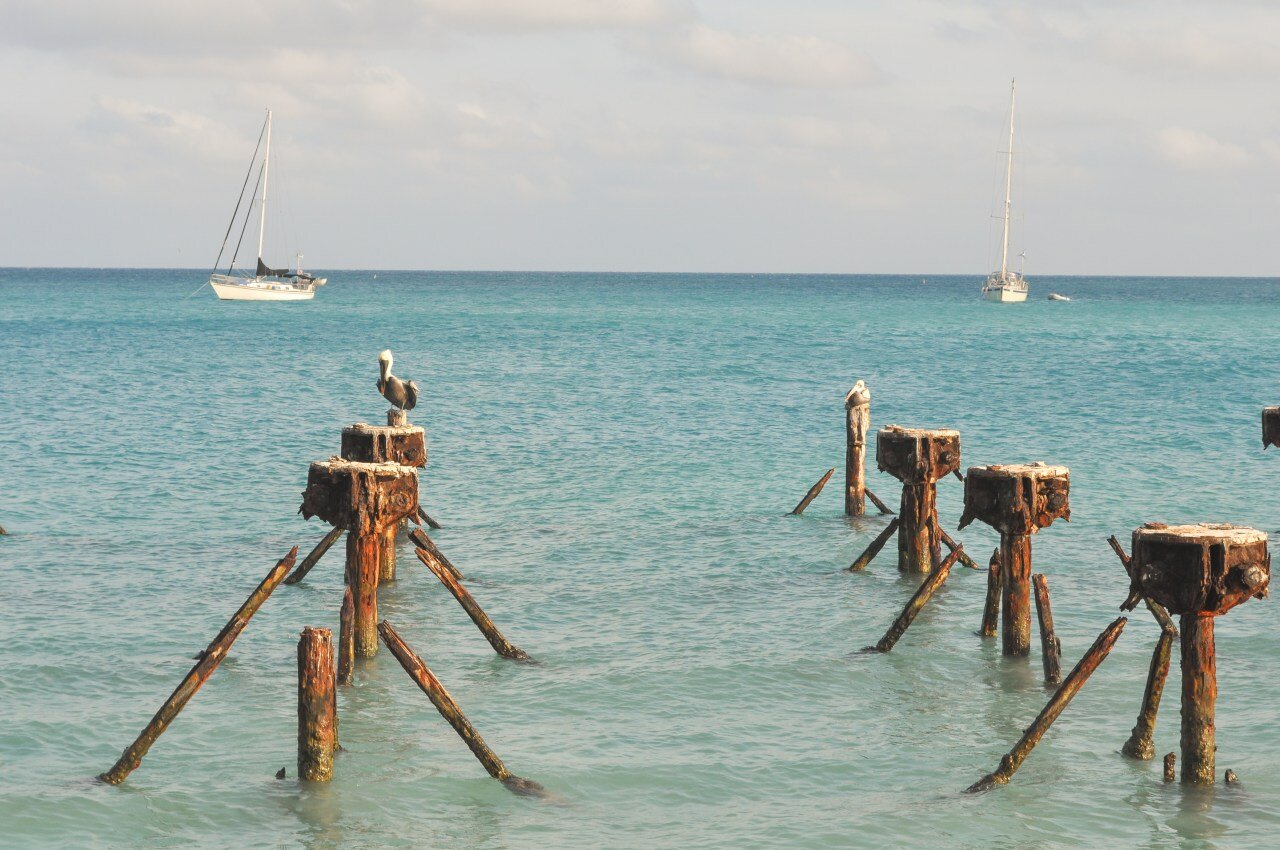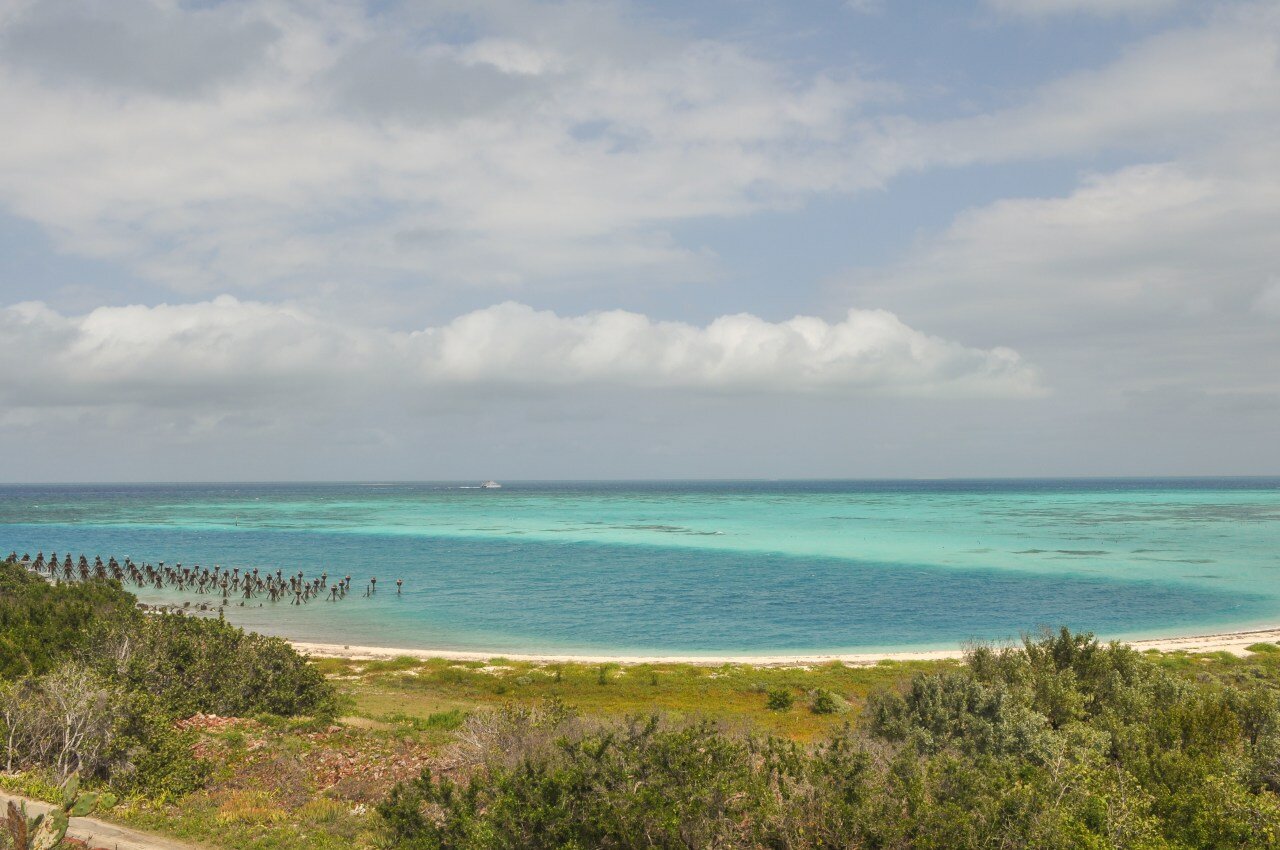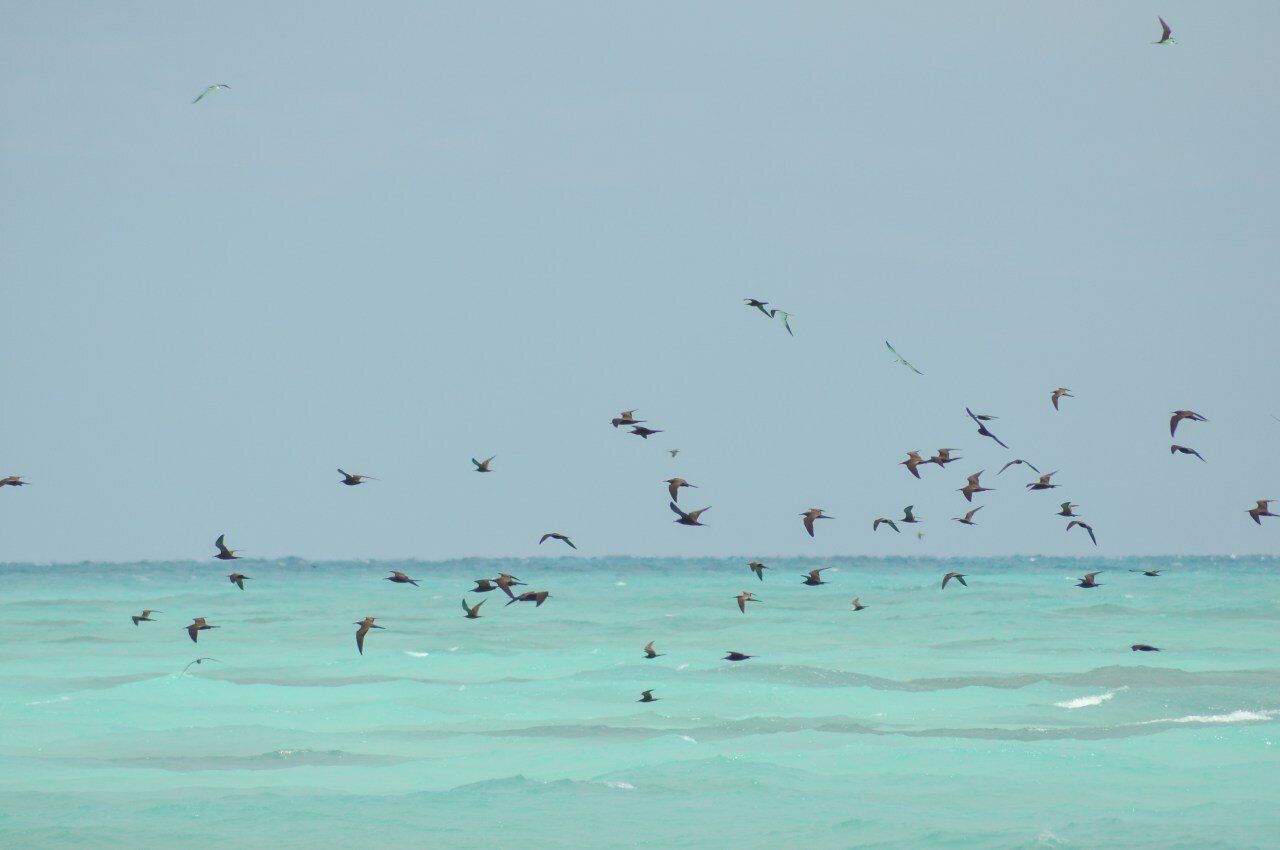A Guide to Dry Tortugas National Park
This is real life.
All the small moments in my life added up to my feet planted in exactly that spot—the grassy rooftop of mighty Fort Jefferson, a 16 million-plus brick fortress situated right in the middle of the bluest waters of the Caribbean. It was one of those “maybe one day I’ll see it” types of places. You know the ones, right? Those places you always say you’ll visit, but somehow seem to be too good to be true? Dry Tortugas was one of those places for me…. except that in that moment, I was standing on it.
Pure magic.
I can’t think of a better way to describe Dry Tortugas National Park than those two words, so maybe I’ll just leave it there and be done with the whole thing. *drops mic*
Just kidding, but only a little bit.
I have started and re-started writing this post multiple times because I have so much to say about this magical place (I’m also going to try and limit the amount of times I use the word “magical”). The truth is that I feel inadequate trying to spell out the shiny rays of light that this place casts on my soul, and I don’t know that I’ll be able to properly convey just how much Dry Tortugas means to me. If nothing else, ignore everything I’m about to say and at least scroll through the photos.
There are a few good resources out there when it comes to Dry Tortugas, but it’s far less written about than some of your more popular parks, and one could argue that it’s also a far more unique experience. So not only am I going to regale the tale of my short stay for those who are interested, I’m also going to hopefully leave you with a few tips to plan an adventure of your own!
Did you know this post is part of a series on Florida National Parks? Read more here!
In a town known for late night shenanigans, all I could hear were waves lapping up lazily against an abundance of boats parked along the shoreline as I drove through Key West that morning. The stormy weather had taken a brief reprieve in the early hours of the day, perfect timing for me to take a quick shower at my campground and finish packing up my bag for the adventure ahead. Now, around 6am, I had dropped off my overnight bags with the boat crew, parked my car at the nearby parking deck, and had nothing to do but wait to board the ferry.
How to Get to the Dry Tortugas
Backing up for a moment, let’s talk about how to get to Dry Tortugas, because there are a few different travel options. Obviously I chose to take the commercial ferry, the Yankee Freedom III, to the island. In my opinion, the ferry is your simplest option, as well as the most affordable. Rounding out at about $200 per ticket, the ferry runs daily and seats about 200 people. However, the commute takes about two and a half hours each way by sea, so for a day trip, you’ll actually end up spending more time on the boat than you will in the park.
For this reason, you may choose to fly into the park on a seaplane. At only 40 minutes each way, a flight cuts your travel time by more than half, but also almost doubles the price of your trip, with the cheapest options starting around $350.
Your secret third option, if you’re not completely satisfied by either of the more standard choices, would be to charter a boat and travel to Dry Tortugas independently. Or, if you own your own watercraft, park that sucker along the coastline of Garden Key and bask in the glory of your DIY adventure. Ain’t nothing holding you back! I hope it goes without saying that you should be an experienced sailor if you’re going to try and sail there. We can all agree on that logic, right?
As a camper, it was an extremely easy choice for me to take the ferry, because (a) I don’t know the first thing about sailing, and (b) a seaplane won’t carry your camping gear. It was ferry or bust.
Speaking specifically about the ferry, there are a few things to note: first, the seats fill up fast. A lot of people opt not to add the Dry Tortugas to their Key West vacation simply due to the unavailability of tickets. I spent some time getting to know a sweet family who love to camp on the island, and they book there trip a year in advance (the earliest possible time) in order to secure their spring break vacation each year.
Second, if you are going to cancel your day trip, you must do so by 3pm the day before your departure. This makes 3pm your golden hour for snagging a last-minute ticket. There are all kinds of reasons one might choose to cancel their day trip, especially if the weather forecast is looking dismal. If you are hoping to scoop up someone else’s discarded seat, make sure you are at the ticket booth in Key West around this time the day before you hope to visit.
I got super lucky. Everything about my road trip hinged on the opportunity to camp at the Dry Tortugas, so when I finally narrowed down where I wanted to spend my week off of work (only two weeks ahead of time), booking my ticket on the Yankee Freedom III was the very first thing that I did. I dialed the phone with fingers crossed, and held my breath as I volunteered the possible dates that I was interested in. Lo and behold, there was one single seat left for an overnight stay!
While the boat carries 200 visitors, they only offer 10 seats on each trip for campers, due to the lack of space for gear. Three couples and a family of three had booked the day that I ended up making the voyage: 9 people. I exhaled, nervous-giggled, and gave my credit card information, securing my position as the tenth and final camper. Being a solo traveler was already starting to pay off!
What It’s Really Like to Be on a Boat in a Storm with a Hangover
I pride myself on my ability to drink responsibly. Especially on my own in the company of those I don’t know, I’m the type to be careful and constantly aware of how much alcohol I’ve consumed. Even still, I was nursing a mild hangover [from my night out] as I boarded the Yankee Freedom III.
The storm that had relented as I prepared for the day now broke out overhead. Buckets of rain poured down as we were herded into the indoor seating of the boat. Not shaken by this sudden change, I would soon realize the effects of a few hours on a rocky boat. Reporting 3-4 foot swells, I stayed in my seat for as much of the ride as possible. Clumsy as I am, trying to walk up and down a crowded aisle on a swaying surface is definitely not in my skill set. The ferry provides a simple breakfast buffet as well as complementary snorkeling gear (for which you sign up before arriving at the island); these were the only two reasons I tried to stand at all during the trip.
Pro Tip: Take Dramamine an hour or two before you set foot on the boat to let it get into your system prior to departure.
You can purchase motion sickness medication in transit, but I opted to bring my own, and shared it around with the new friends I had made. The longer the ride went on, the more people started to lose their breakfast. Just don’t look at it and you’ll be fine became my survival mantra for the tail end of the journey… yet another reason I was thrilled to finally set foot on Garden Key.
Setting up Camp on Garden Key
By the time we reached our destination, it was still very windy but not raining for a moment. While everyone else exited the ferry, all campers remained onboard for a quick orientation with a national park ranger. As eager as I was to get off that boat, I was glad for an opportunity to speak with a ranger and have any questions answered. As it turns out, I actually worked with this particular park ranger at his last assignment, although we had never met in person. Park rangers don’t get enough credit for the hard work that they do, and it was nice to have an opportunity to get to know a little bit about one of the individuals who protects our public lands!
We walked to the campground as we talked, since I was racing the skies to pitch my tent. I traveled light, with just a hiking pack and my camera bag, but the amount of gear you can bring is not limited. For your convenience, the park provides large wheelbarrows to help you transport your things to your desired site. I picked a site, erected my tent, and threw my belongings inside it, just barely making it to the fort entrance before the heavens opened up again.
What even are the Dry Tortugas?
The Dry Tortugas is a collection of seven keys—islands formed by coral instead of volcanoes—that are situated 70 miles due west of Key West. The most significant key for tourists is Garden Key, home to Fort Jefferson. If you visit for the day, this is where you will spend your time. Garden Key is connected by a land bridge to Bush Key; being a popular breeding ground for many bird species (including, most notably in my opinion, the magnificent frigatebird), Bush Key is closed to visitors from February to September each year. The largest of the group, Loggerhead Key, is also open to visitors, but you have to get yourself there by your own private boat or kayak. Being west of Garden Key, campers are afforded a beautiful view of the sun setting behind the Loggerhead Key each evening.
Due to the fragility of these low, sandy islands as well as the fragility of their ecosystems, most of them are not open to visitors. Originally named “Las Tortugas” by Ponce de Leon in 1513, the keys are a favorite nesting ground for sea turtles and found in abundance in the area. However, all five species that nest in the Dry Tortugas may be found on the threatened or endangered species list, and very strict laws are in place protecting these animals.
Exploring Fort Jefferson
The storm raged on, forcing most of the visitors into the relative dryness found inside the fort walls. I wandered around the bottom floor of the fort, before making my way up a set of narrow, slippery stairs to the second floor. With open space on either side (and no railing), wind and rain came surging into the fort horizontally. A glorious, magical sight, I was unable to capture any of the moment on camera for fear that water may seep into my bag and make a home there. I laughed with glee at the sight of it all, and then retreated back toward safer ground.
In young, 19th century America, it was actually faster and more affordable to ship items by waterways rather than over land. To ship something from, say, Ohio to New York, one would put their precious cargo on a boat headed down the Mississippi River, around the Florida Keys, and back up the East Coast on the Atlantic Ocean. In a world of same-day shipping, this seems nightmarishly exhausting.
The small group of islands was found to have deep harbors, making it a perfect place for an enemy naval fleet to set up camp. Due to the Dry Tortugas’ geographical position between Florida and Cuba, in the pathway from the Gulf of Mexico to the Atlantic, the United States deemed it necessary to construct a fort to protect their waterways. For a new nation without a comparable Navy, a gigantic fort seemed like a smart way to display some power in the seas.
Lunch on the Ferry
Around noon, I began wishing I was wearing my swimsuit. (Note to self: put on a swimsuit in the morning next time, before you even board the ferry.) Unfortunately, in order to make that dream into a reality, I would have to unzip my tent in the middle of the torrential downpour, and that was not about to happen. At that moment, I realized that my lunch was also inside my tent.
If you choose to visit the Dry Tortugas on a day trip, you pretty much don’t have to worry about bringing food at all, because the boat provides a breakfast and a lunch spread. As a camper, you are given the choice of a meal on the boat for one day of your visit. I had chosen the following day, but with the inaccessibility of my personal food that I was now facing, I hopped back onto the Yankee Freedom to eat.
I joined the throng of soaking wet people seeking asylum from the rain on the Yankee Freedom III, but in a serendipitous and magical turn of events, the sun finally, finally began to peek out from the clouds just as I finished my tuna salad sandwich. Hopping off the boat as fast as one can in a giant crowd of people, I grabbed some snorkel gear and ran to check on my tent. It had survived the storm with no problems at all, so I popped in to change into my swimsuit and pull back my wet hair.
Snorkeling Fail
Wandering back toward the fort and down the northeastern side of the moat, the island appeared to be a totally new place in the sunlight. The previously imposing fort now beckoned to me for further adventure, and I soon found myself on the top level of the fort on a grassy ledge overlooking Bush Key. After pausing to journal and collect myself, I decided it might a good moment to try snorkeling.
Garden Key has two separate beaches on the north and south sides of the island. Both provide access to coal pilings, as well as the moat wall (you can snorkel next to the moat wall, but not inside the moat). The campground is on the south beach, so I chose to attempt my very first snorkel ever at this beach.
Spoiler alert: it went terribly. First of all, I was in the water alone. A young couple lounged on the beach with their children and I asked them to keep an eye on me, but this didn’t quell the fear that came with being in the water alone. And I wouldn’t call the water murky, per se, but the visibility was very low, which made me hesitant to swim forward and fearful for what could potentially swim up unseen behind me. My childhood love of sharks and therefore inundation with shark attack stories probably didn’t help!
Scared to swim forward, I barely made it past the waves, which would break over me and insist on pushing me back toward shore. The couple came to my rescue, and allowed me to try their snorkel gear, which was much nicer than the complementary gear I had borrowed from the boat. Even still, I lasted maybe thirty seconds before washing up on the shoreline again like a battered piece of driftwood.
Feeling defeated, I succumbed to the will of the waves and parked myself in the sand with my new friends. By this time it was late afternoon and the ferry was headed back to Key West with the daytime visitors. The small beach that would be packed with visitors the following morning was almost empty. I learned from my friends that they were vacationing with another couple and their kids—the five of us and the little ones were the only ones in sight.
Garden Key Campground
Camaraderie turned into a dinner invitation, so I stuck around camp as I dried from my miserable snorkeling attempt. The small campground is sheltered by trees and bushes, with a grill and picnic table at each site. Park rangers came to inform us that the winds, which were already strong, would reach 40mph that night. I hadn’t yet staked down my tent, so we picked it up and moved it into the bushes as much as possible, to gain as much cover from the wind as we could.
I combed the trees for the biggest hermit crabs before dinner, which turned out to be quite a source of entertainment. The island is absolutely crawling with them!
Dinner consisted of steak, rice, salad, and wine…a much more impressive spread than the sandwich that I had packed for myself. They insisted that I help myself to seconds, as there was no adequate storage for leftovers. I still can’t believe the generosity of these strangers welcoming me to their table.
The sun set around 7:30pm, and I took one more jaunt around the fort before finding refuge from the wind in my tent. With full intentions to get back out and see the stars, I sank into a restless night of sleep with fervent winds raging around me.
Morning, Day Two
The following morning, I got dressed in the leggings that I had thought I was bringing for bug protection. The air was crisp and chilly, and I emerged sleepy-eyed from my tent around 8:30am. I hadn’t found the willpower to face the wind that night, and stayed holed up in my tent as long as I could. I ate a quick breakfast of beef jerky before packing up camp. The “dry” part of “Dry Tortugas” was added to the name in order to indicate that there is not a source of freshwater on the island. Because of this, it is recommended that at least a gallon of water per visitor per day be brought with any camper. I had a good amount of leftover water with me as I packed up, so I filled up my water bottle and left the rest with my friends.
The boat would be back with a fresh group of visitors around 10:30, and I had hoped to try snorkeling again before the influx of humans. I walked to the north beach with a retired couple who had the same hope, but after the windstorm from that night, the water was far too rough. Instead, I retreated to the moat where I ran into the same park ranger I met the day before. As fish gathered below us at the moat wall, he observed that visitors had been feeding the fish, which resulted in this dog-like devotion to humans.
Fort Jefferson Guided Tour
After the ferry docked and emptied, I joined the guided tour of the fort. The tour is hosted by the ferry guide and explains the reason behind the structure, as well as fun facts and interesting architectural decisions made. I found the tour guide to be quite knowledgeable and passionate about the history of the fort and the park in general.
Bush Key Birding
After lunch on the boat (again), I ventured toward Bush Key, which I had left unexplored the day before. I visited in March, which meant that the key was not accessible due to nesting season. I walked as far as I could on a trail that leads through brush and succulents. It was here that I found a small group of individuals who had visited the Tortugas for a very specific reason: the birds. Large cameras and even larger telescopes mounted in the sand, these few had set up for a day of bird watching in a birdwatcher’s paradise. I had already admitted my inadequacy at bird photography in the Everglades, so I allowed myself the enjoyment of the passion of others without the frustration of my limited skills. One gentleman gave me a glimpse into his telescope, where I viewed an absolute swarm of sooty terns and frigatebirds.
Other Things to Do at the Dry Tortugas
Snorkeling is, of course, a big draw to the islands, but the Dry Tortugas is also home to many shipwrecks that are great places to scuba dive. The most popular dive site is the Windjammer shipwreck, found just southwest of Loggerhead Key. Summer visits are better suited for dive adventures, as the water is calmer and clearer.
One day when I revisit the Dry Tortugas, I will make it a priority to kayak out to Loggerhead Key. Even without going all the way to Loggerhead Key, kayaking would be a great way to get another perspective of this national park.
Final Thoughts
I’m finishing up this blog post almost a year and half after my visit to Dry Tortugas National Park and I have visited a handful of other equally extraordinary places since then, but the magic I experienced in the Dry Tortugas is still palpable. I think it was a perfect melting pot of a few things—the bucket-list-ness of the place itself, the warmth and generosity of literally every person I met, and the empowering realization that I have the power to make my own dreams come true. I have also heard mixed sentiments of the ferry ride, and the “booze cruise” feel that it can have. It turns out that the stormy ride I had on the first day kept only the most devoted park enthusiasts in the seats, which shaped my perspective of the small island grouping (not to mention that I slept the entire ride home the next day).
I think that, regardless of the expense involved in reaching this magical location, you should make it a priority if you’re ever given the opportunity to see Dry Tortugas National Park. There is nothing else like it in our park system.
The magic is real.







